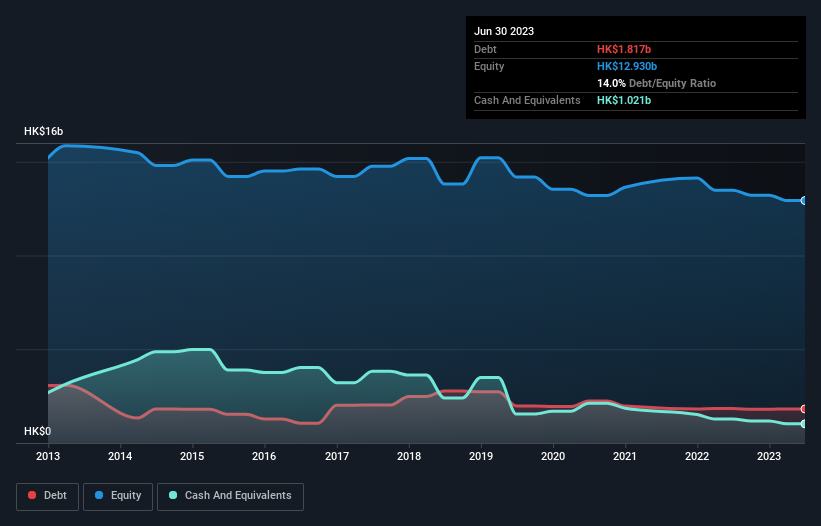
The external fund manager backed by Berkshire Hathaway's Charlie Munger, Li Lu, makes no bones about it when he says 'The biggest investment risk is not the volatility of prices, but whether you will suffer a permanent loss of capital.' So it might be obvious that you need to consider debt, when you think about how risky any given stock is, because too much debt can sink a company. Importantly, Lippo Limited (HKG:226) does carry debt. But should shareholders be worried about its use of debt?
When Is Debt Dangerous?
Debt and other liabilities become risky for a business when it cannot easily fulfill those obligations, either with free cash flow or by raising capital at an attractive price. Part and parcel of capitalism is the process of 'creative destruction' where failed businesses are mercilessly liquidated by their bankers. However, a more usual (but still expensive) situation is where a company must dilute shareholders at a cheap share price simply to get debt under control. Of course, the upside of debt is that it often represents cheap capital, especially when it replaces dilution in a company with the ability to reinvest at high rates of return. When we examine debt levels, we first consider both cash and debt levels, together.
See our latest analysis for Lippo
What Is Lippo's Debt?
As you can see below, Lippo had HK$1.82b of debt, at June 2023, which is about the same as the year before. You can click the chart for greater detail. On the flip side, it has HK$1.02b in cash leading to net debt of about HK$795.4m.

How Strong Is Lippo's Balance Sheet?
The latest balance sheet data shows that Lippo had liabilities of HK$1.15b due within a year, and liabilities of HK$1.19b falling due after that. Offsetting these obligations, it had cash of HK$1.02b as well as receivables valued at HK$177.0m due within 12 months. So its liabilities total HK$1.14b more than the combination of its cash and short-term receivables.
This deficit casts a shadow over the HK$626.3m company, like a colossus towering over mere mortals. So we'd watch its balance sheet closely, without a doubt. After all, Lippo would likely require a major re-capitalisation if it had to pay its creditors today. There's no doubt that we learn most about debt from the balance sheet. But you can't view debt in total isolation; since Lippo will need earnings to service that debt. So when considering debt, it's definitely worth looking at the earnings trend. Click here for an interactive snapshot.
In the last year Lippo wasn't profitable at an EBIT level, but managed to grow its revenue by 10.0%, to HK$750m. That rate of growth is a bit slow for our taste, but it takes all types to make a world.
Caveat Emptor
Importantly, Lippo had an earnings before interest and tax (EBIT) loss over the last year. Indeed, it lost a very considerable HK$148m at the EBIT level. Considering that alongside the liabilities mentioned above make us nervous about the company. It would need to improve its operations quickly for us to be interested in it. But on the bright side the company actually produced a statutory profit of HK$23m and free cash flow of HK$52m. So one might argue that there's still a chance it can get things on the right track. When analysing debt levels, the balance sheet is the obvious place to start. However, not all investment risk resides within the balance sheet - far from it. For instance, we've identified 3 warning signs for Lippo that you should be aware of.
If you're interested in investing in businesses that can grow profits without the burden of debt, then check out this free list of growing businesses that have net cash on the balance sheet.
New: AI Stock Screener & Alerts
Our new AI Stock Screener scans the market every day to uncover opportunities.
• Dividend Powerhouses (3%+ Yield)
• Undervalued Small Caps with Insider Buying
• High growth Tech and AI Companies
Or build your own from over 50 metrics.
Have feedback on this article? Concerned about the content? Get in touch with us directly. Alternatively, email editorial-team (at) simplywallst.com.
This article by Simply Wall St is general in nature. We provide commentary based on historical data and analyst forecasts only using an unbiased methodology and our articles are not intended to be financial advice. It does not constitute a recommendation to buy or sell any stock, and does not take account of your objectives, or your financial situation. We aim to bring you long-term focused analysis driven by fundamental data. Note that our analysis may not factor in the latest price-sensitive company announcements or qualitative material. Simply Wall St has no position in any stocks mentioned.
About SEHK:226
Lippo
An investment holding company, engages in food manufacturing and retail operations through chains of cafés and bistros in Hong Kong, Mainland China, Singapore, Malaysia, Indonesia, and internationally.
Excellent balance sheet and good value.
Similar Companies
Market Insights
Community Narratives



